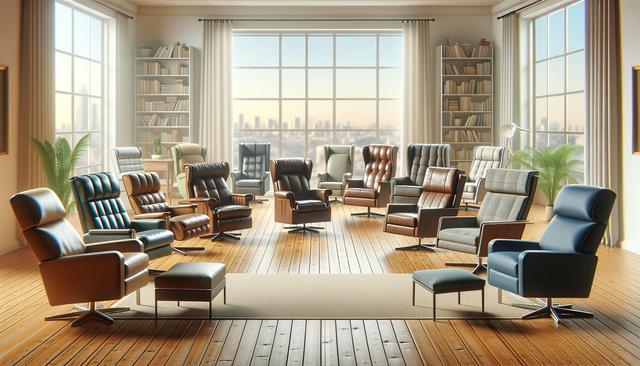
This Chair Is Quietly Replacing Recliners Across The Country
Why Traditional Recliners Are Losing Ground
Recliners have long been a living room staple, known for their plush comfort and ability to offer physical relief. However, many consumers are starting to shift away from these bulky furniture pieces in favor of alternatives that provide similar, if not enhanced, support without compromising on space or style. One of the main reasons behind this transition is the evolving needs of homeowners who are seeking functional yet aesthetically pleasing furniture.
Traditional recliners are often large, heavy, and difficult to integrate into modern home layouts. They may also lack the ergonomic design elements that newer chairs provide. While some of the best ergonomic recliners for back pain relief still hold a significant market share, the introduction of more compact and supportive options is reshaping consumer preferences.
Another factor influencing this shift is the rise of minimalistic design trends. Sleek, multi-functional seating with clean lines and ergonomic features is becoming increasingly attractive to individuals who value both comfort and visual appeal.
The Rise of Ergonomic Lounge Chairs
Ergonomic lounge chairs are emerging as a popular alternative, offering a combination of comfort, posture support, and design adaptability. These chairs are often engineered to align with the natural curvature of the spine, which can help reduce strain and promote better posture over long periods of use.
Some of the key features that have made ergonomic lounge chairs a preferred choice include:
- Adjustable lumbar support
- Contoured seating for weight distribution
- Compact footprint suitable for smaller spaces
- Modern design that integrates well with different interiors
As people become more aware of the importance of spinal health, chairs that offer tangible benefits in this area are gaining favor. Among the best ergonomic recliners for back pain relief, many newer models incorporate these ergonomic features, but in a more streamlined form.
Health Benefits Driving the Shift
One of the most significant reasons consumers are opting for ergonomic chairs over traditional recliners is health. Recliners, though comfortable, may not always provide adequate support for the lower back, especially if used for extended periods. This can lead to discomfort or even chronic pain over time. Ergonomic chairs, on the other hand, are designed with health in mind.
These chairs promote movement and correct spinal alignment, which can reduce the risk of developing musculoskeletal issues. For individuals dealing with existing discomfort, choosing one of the best ergonomic recliners for back pain relief can contribute to improved daily comfort and long-term wellness.
Additional health-related advantages of switching to ergonomic alternatives include:
- Enhanced blood circulation due to better posture
- Reduced muscle fatigue by distributing body weight evenly
- Prevention of slouching, which can lead to spinal misalignment
This focus on health has positioned ergonomic chairs not just as a luxury, but as a practical investment for overall well-being.
Space-Saving and Versatility Considerations
Modern homes are often designed with open floor plans and limited space, making bulky furniture less practical. Ergonomic chairs offer a space-saving solution without sacrificing comfort. Their lightweight and compact designs make them easier to move, rearrange, and even transport, which adds to their appeal for urban dwellers and small-space living.
These chairs also tend to be more versatile than traditional recliners. While recliners are generally fixed in their function, ergonomic chairs can serve multiple purposes—from reading and working to relaxing and even meditating. Some models come with interchangeable cushions, adjustable settings, and swivel bases that enhance usability across various scenarios.
For those looking to maximize their living space without compromising on comfort, ergonomic chairs provide a compelling alternative. Even among the best ergonomic recliners for back pain relief, the more versatile models are seeing increased popularity due to their adaptability and minimal footprint.
Consumer Trends and Market Response
The furniture industry has taken notice of this shift, with more brands introducing ergonomic seating options designed to replace traditional recliners. Consumer reviews and sales data reflect a growing interest in chairs that combine function with form. Online search trends also indicate a surge in queries related to ergonomic furniture, especially among individuals seeking solutions for back pain and posture support.
Retailers are expanding their offerings to include a variety of ergonomic chairs tailored for different needs—ranging from work-from-home setups to leisure seating. Some of the most highly rated models are being recognized among the best ergonomic recliners for back pain relief, further validating their effectiveness and appeal.
This evolving market landscape suggests that the trend is here to stay. As more consumers prioritize health, space efficiency, and modern aesthetics, the demand for ergonomic chair alternatives continues to rise.
Conclusion: A Smarter Choice for Modern Living
As comfort and health become increasingly important factors in furniture selection, it’s no surprise that ergonomic chairs are quietly replacing traditional recliners across the country. These chairs offer a balanced combination of support, design, and practicality—making them an appealing choice for a wide range of users.
Whether you’re redesigning your living room, upgrading your home office, or simply looking for better back support, exploring options among the best ergonomic recliners for back pain relief can help you find a solution that meets your needs. With the right chair, you can enjoy both comfort and long-term wellness without sacrificing style or space.